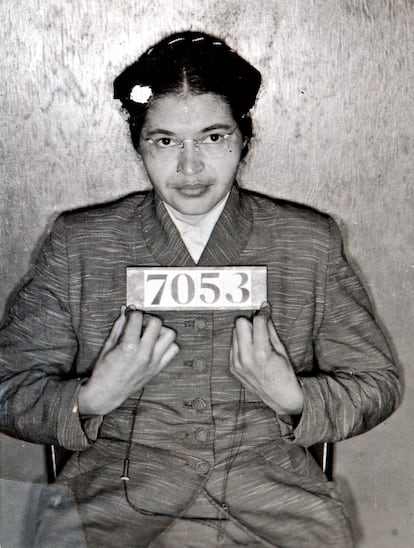Rosa Parks’ Day: The arrest that became a symbol for civil rights
The activist is now known as the ‘Mother of the Civil Rights Movement’ for refusing to give up her seat in 1955. This is the story of how it happened

On December 1, 1955, Rosa Parks refused to stand up and give her bus seat to white passengers, which led to her arrest and eventually inspired several movements that led to the fight for civil rights. Parks was a well-educated woman who had learned about the struggles of African-Americans in a segregated country. She was active in the local National Association for the Advancement of Colored People (NAACP), which had an important influence in her decision to defend her rights.
Before Parks, other African Americans started protesting bus segregation through sit-ins in buses. Bayard Rustin, leader in social movements for civil rights, was the first one arrested for protesting by sitting in the first rows of a Louisville bus bound for Nashville. After him, Irene Morgan, Lillie Mae Bradford and Sarah Louise Keys also protested by refusing to stand up.
The same year Rosa Parks was arrested, four Black women were arrested in Montgomery for not giving up their seats. They were 15-year-old Claudette Colvin, 18-year-old Mary Louise Smith, 36-year-old Aurelia Browder and Susie McDonald, who was around her seventies at the time of her arrest. They became the plaintiffs of Browder v. Gayle, the case which led to bus segregation being considered unconstitutional.
December 1, 1955
42-year-old Rosa Parks was on her way home from the Montgomery Fair department store, where she had been working as a seamstress. She had to take a bus, so she boarded one and took a seat.
She was seated in the first row behind 10 seats permanently reserved for white passengers. As the bus became crowded the bus driver told Parks and other three African American passengers seated in that row to stand up so that the white passengers could sit.
Parks had encountered the bus driver before. His name was James Blake. 12 years earlier, she had a confrontation with him after he demanded that she exit the bus and board through the rear door. When she exited through the front door, he sped away before she could board again. Parks also knew that he had humiliated other Black passengers over the years and that he carried a pistol in a holster.
When Blake asked her to move, she was also aware of what had happened to another black woman, Clauidette Colvin, who was mistreated for not giving up her seat. Douglas Brinkley, one of her biographers, described Rosa Parks as fearless, bold, and serene when she looked at the driver and replied “No”.

Blake again demanded that Rosa and the other Black passengers on that row gave up their seats. The three passengers moved, but Parks remained seated. “As I sat there, I tried not to think about what might happen,” Parks later wrote in her autobiography. “I knew that anything was possible. I could be manhandled or beaten. I could be arrested. People have asked me if it occurred to me then that I could be the test case the NAACP [National Association for the Advancement of Colored People] had been looking for. I did not think about that at all. In fact if I had let myself think too deeply about what might happen to me, I might have gotten off the bus”. Parks said that she also thought of the death of Emmett Till, a 14-year-old Black kid who was lynched in Mississippi that same year. “I just couldn’t go back”.
Parks argued that she was not in a seat reserved for whites. Although the law wasn’t very clear on that point, Blake believed he could move the separating line between Black and white passengers, so he threatened to call the police, which he did after Parks refused to stand up. Two Officers, Day and Mixon, arrived at the scene and arrested Parks. “Why do you push us around”?, she asked one Officer who just replied: “I don’t know, but the law’s the law, and you’re under arrest”.
Parks was taken into custody, where she was booked, fingerprinted and briefly imprisoned. The report read: “We received a call, upon arrival the bus operator said he had a colored female sitting in the white section of the bus, and would not move back”. She was charged with a violation of Chapter 6, Section 11, segregation law of the Montgomery City code, which stated that no “colored” person could take a “White-only seat”. However, she technically had not done that, as she was sitting in a colored section.

Edgar Nixon, president of the Montgomery Chapter of the NAACP and her friend Clifford Durr paid her bail, and she was released. Nixon discussed the event with Jo Ann Robinson, member of the Women’s Political Council (WPC), who believed it was important to seize the opportunity and begin a bus boycott in Montgomery. Word about the boycott quickly spread within the Black community.
On December 6, Parks was tried on charges of disorderly conduct and violating a local ordinance. She was found guilty and fined. After the trial, Parks appealed her conviction and challenged the legality of racial segregation.
Browder v Gayle
Although the Rosa Parks case took place a few months after the plaintiffs of Browder v. Gayle’s, the attorney Fred Gray decided not to include her in the case because they didn’t want to create the impression that they wanted to circumvent her prosecution on her charges which, at the time, were working their way through the Alabama court system. A three-judge U.S. District Court panel ruled two-to-one that segregation on Alabama’s buses was unconstitutional, citing Brown v. Board of Education as a precedent. The case was decided on June 4, 1956 and it was upheld by the U.S. Supreme Court on November 13, 1956.
Martin Luther King Jr., who at the time was minister of the Dexter Avenue Baptist Church, became a leader of the boycott that lasted 381 days, achieving national fame, which later he would use to continue to fight for the civil rights movement across the country.
Sign up for our weekly newsletter to get more English-language news coverage from EL PAÍS USA Edition
Tu suscripción se está usando en otro dispositivo
¿Quieres añadir otro usuario a tu suscripción?
Si continúas leyendo en este dispositivo, no se podrá leer en el otro.
FlechaTu suscripción se está usando en otro dispositivo y solo puedes acceder a EL PAÍS desde un dispositivo a la vez.
Si quieres compartir tu cuenta, cambia tu suscripción a la modalidad Premium, así podrás añadir otro usuario. Cada uno accederá con su propia cuenta de email, lo que os permitirá personalizar vuestra experiencia en EL PAÍS.
¿Tienes una suscripción de empresa? Accede aquí para contratar más cuentas.
En el caso de no saber quién está usando tu cuenta, te recomendamos cambiar tu contraseña aquí.
Si decides continuar compartiendo tu cuenta, este mensaje se mostrará en tu dispositivo y en el de la otra persona que está usando tu cuenta de forma indefinida, afectando a tu experiencia de lectura. Puedes consultar aquí los términos y condiciones de la suscripción digital.
More information
Archived In
Últimas noticias
Most viewed
- Reinhard Genzel, Nobel laureate in physics: ‘One-minute videos will never give you the truth’
- Oona Chaplin: ‘I told James Cameron that I was living in a treehouse and starting a permaculture project with a friend’
- Pablo Escobar’s hippos: A serious environmental problem, 40 years on
- Charles Dubouloz, mountaineering star, retires at 36 with a farewell tour inspired by Walter Bonatti
- Why we lost the habit of sleeping in two segments and how that changed our sense of time











































